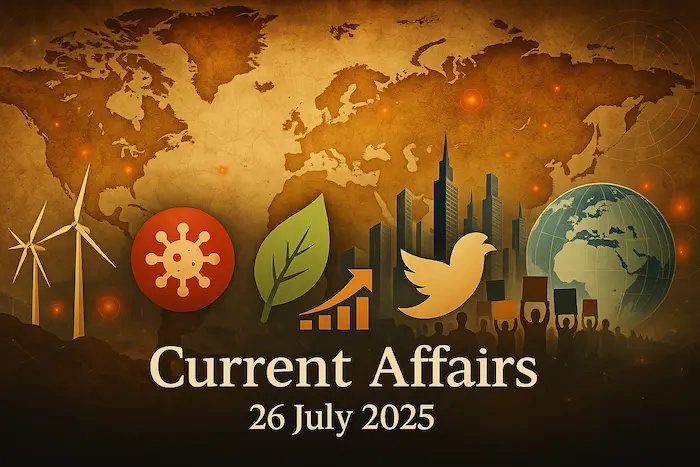1. National Crisis Management Committee (NCMC) – Polity

Why in News?
The Central Government has recently activated the National Crisis Management Committee (NCMC) to handle a major disaster situation with national-level implications.
Key Takeaways
- The NCMC is established under the Disaster Management Act, 2005.
- It is the apex body for handling national-level disasters.
- Chaired by: Cabinet Secretary of India (Note: not Cabinet Minister – correction based on official structure).
- Members include:
- Union Home Secretary
- Secretary, Defence
- Chairman, National Disaster Management Authority (NDMA)
- Heads of other relevant ministries and organizations
- Can co-opt experts or officials from central/state governments or other bodies.
- Functions include:
- Evaluating disaster preparedness
- Issuing directions for readiness and response
- Coordinating efforts among ministries, state governments, and NGOs
In-Depth Explanation
The National Crisis Management Committee (NCMC) plays a crucial role in India’s disaster response system. Established under the Disaster Management Act, 2005, it serves as the highest coordinating authority during catastrophic events such as large-scale natural disasters, pandemics, or industrial accidents that have nationwide implications.
The NCMC ensures:
- Unified command and control during emergencies.
- Efficient coordination between various ministries, state governments, and non-governmental actors.
- Resource allocation and rapid decision-making to minimize loss of life and property.
The recent invocation of the NCMC demonstrates the central government’s intent to institutionalize crisis response, reduce bureaucratic delays, and uphold cooperative federalism in disaster management. The ability to co-opt experts enhances the technical competence of the committee, making it more agile and responsive.
Exam Connect – Possible Questions
Prelims
1. Which of the following statements about the National Crisis Management Committee (NCMC) is correct?
A. It is a statutory body established under the Epidemic Diseases Act, 1897
B. It is chaired by the Union Home Minister
C. It coordinates disaster response at the national level
D. It only functions during state-level emergencies
Answer: C. It coordinates disaster response at the national level
2. The National Crisis Management Committee (NCMC) can co-opt members from:
A. Only central government ministries
B. Only state governments
C. Any relevant government or non-government organization
D. Only NDMA and Ministry of Home Affairs
Answer: C. Any relevant government or non-government organization
Mains
1. Discuss the role and significance of the National Crisis Management Committee (NCMC) in India’s disaster management framework. How does it enhance inter-governmental coordination during national emergencies?
2. Critically evaluate the institutional response mechanisms for disaster management in India. What improvements are necessary to strengthen national preparedness and resilience?
2. Extension of President’s Rule in Manipur – Polity
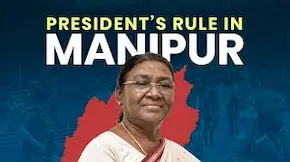
Why in News?
The Union Home Minister is set to introduce a statutory resolution in the Rajya Sabha to extend President’s Rule in Manipur for an additional six months, amid continuing law and order issues.
Key Takeaways
- President’s Rule implies the suspension of the elected state government, placing the state under direct control of the Union Government.
- Constitutional Basis:
- Article 355: Obligation of the Union to protect states from external aggression and internal disturbance.
- Article 356: President can assume state functions if there is a breakdown of constitutional machinery.
- Article 365: Failure of a state to comply with Union directions can trigger Article 356.
- Duration:
- Initially imposed for 6 months.
- Can be extended every 6 months, but not beyond 3 years, with Parliament’s approval.
- Revocation:
- Can be revoked at any time by the President under Article 356(2), without parliamentary approval.
In-Depth Explanation
The extension of President’s Rule in Manipur reflects the challenges of governance in a volatile socio-political climate. Under Article 356, if the Governor reports a failure of constitutional machinery, the Union can impose President’s Rule. In such cases, the President assumes control, and the state is administered through the Governor on behalf of the Union.
This development has renewed constitutional and political debates:
Judicial Oversight:
- S.R. Bommai v. Union of India (1994):
- Made President’s Rule subject to judicial review.
- Mandated that a floor test be the only constitutional method to test a government’s majority.
- Rameshwar Prasad Case (2006):
- Criticized arbitrary dissolution of state assemblies.
- Sarbananda Sonowal Case (2005):
- Widened the Union’s preventive powers in certain cases.
Key Recommendations from Committees:
- Sarkaria Commission (1987):
- Use Article 356 as a last resort.
- Punchhi Commission (2010):
- Suggested applying emergency only in affected areas, not entire states.
- NCRWC (2000):
- Proposed amendments to prevent misuse of Article 356.
- Recommended limited President’s Rule even without National Emergency if elections are not feasible.
The current extension in Manipur must be viewed not just as a law and order measure, but also as a test of India’s federal structure, balancing state autonomy with national interest.
Exam Connect – Possible Questions
Prelims
1. Which Article of the Indian Constitution allows the Union Government to impose President’s Rule in a state?
A. Article 352
B. Article 355
C. Article 356
D. Article 360
Answer: C. Article 356
2. The maximum period for which President’s Rule can be extended in a state with parliamentary approval is:
A. 6 months
B. 1 year
C. 2 years
D. 3 years
Answer: D. 3 years
3. The judgment in S.R. Bommai v. Union of India is related to:
A. Environmental regulation
B. Judicial appointments
C. President’s Rule and federalism
D. Electoral reforms
Answer: C. President’s Rule and federalism
Mains
1. Critically examine the constitutional provisions and judicial safeguards related to the imposition and extension of President’s Rule in states. Discuss in light of the recent extension in Manipur.
2. Evaluate the relevance of the Sarkaria and Punchhi Commission recommendations in preventing the misuse of Article 356. How far have these been implemented in practice?
3. President’s Rule is often criticized as being politically motivated rather than constitutionally necessary. Do you agree? Substantiate with recent examples.
3. Electoral Disenfranchisement and the Fault Lines in India’s Electoral Architecture – Governance
Why in News?
The Election Commission of India (ECI) is concluding the first phase of its Special Intensive Revision (SIR) of electoral rolls in Bihar by August 1, 2025. This has sparked a debate on alleged disenfranchisement, especially of the poor, minorities, and internal migrants.
Key Takeaways
- Special Intensive Revision (SIR): A voter list updating exercise conducted by the ECI, aimed at removing duplicates and verifying entries.
- Disenfranchisement Concerns:
- Over 1.2 million voters removed in Bihar alone.
- Highest deletion rates (5–7%) observed in high-migration districts.
- Legislative Basis:
- Representation of the People Act, 1950: Governs electoral rolls and assumes voter residency in birthplace/local constituency.
- Internal Migration in India:
- Over 450 million internal migrants, yet electoral laws do not accommodate mobile populations.
- Citizenship vs. Residency:
- ECI’s process gives priority to residency, leading to exclusion of mobile or migrant citizens.
- International Best Practices:
- USA, Australia, Philippines have voter-friendly mechanisms (e.g., online registration, absentee ballots) to balance electoral integrity and inclusiveness.
In-Depth Explanation
India’s electoral framework, designed over 70 years ago, is increasingly outdated for the demographic realities of a modern, mobile society. The assumption that a citizen votes in their place of origin no longer holds true in an era marked by rapid urbanization and internal migration.
The Representation of the People Act, 1950 is rooted in a rural, static population model. It fails to accommodate over 450 million internal migrants, resulting in:
- Voter exclusion from both source and destination constituencies.
- A skewed representation in governance structures.
- Political apathy among the youth and urban poor who face barriers to registration.
The conflation of citizenship with residency means that even though individuals hold Indian citizenship, lack of proof of residence or absence during verification leads to deletion of names from the electoral roll.
This has a direct impact on democracy:
- Undermines the principle of universal adult suffrage.
- Allows political actors to exploit voter suppression for electoral gains.
- Reduces trust in electoral institutions.
The Way Forward:
- Legislative Reform: Amend the Representation of the People Act to allow more flexible, technology-driven voter registration.
- Portable Voter Identity: Introduce mechanisms like One Nation, One Voter ID or remote voting.
- ECI Reforms: Ensure transparency and accountability in roll revision and improve communication with affected communities.
- Political and Civil Society Role: Advocacy, voter awareness, and outreach to the marginalized can bridge trust deficits.
Exam Connect – Possible Questions
Prelims
1. The Representation of the People Act, 1950 deals primarily with:
A. The conduct of elections
B. Delimitation of constituencies
C. Preparation of electoral rolls
D. Powers of the Election Commission
Answer: C. Preparation of electoral rolls
2. Which of the following is a major challenge in maintaining inclusive electoral rolls in India?
A. High voter turnout
B. Use of EVMs
C. High internal migration
D. Low literacy rates
Answer: C. High internal migration
3. The term “Special Intensive Revision (SIR)” in the context of Indian elections refers to:
A. Training of polling officers
B. A legal process for delimiting constituencies
C. Detailed verification and updating of electoral rolls
D. A campaign to increase voter turnout
Answer: C. Detailed verification and updating of electoral rolls
Mains
1. India’s electoral laws have failed to keep pace with the demographic shifts in society. Critically examine the need for reform in the Representation of the People Act, 1950 in light of increasing internal migration.
2. Discuss the role of the Election Commission of India in ensuring both electoral integrity and voter inclusiveness. How can the ECI address disenfranchisement without compromising on accuracy?
3. What lessons can India learn from international electoral systems to improve access and participation for internal migrants and marginalized groups? Suggest feasible reforms.
4. National Cooperative Policy 2025 – Revitalising India’s Cooperative Movement – Polity
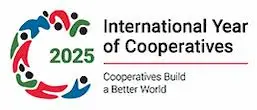
Why in News?
Union Home and Cooperation Minister Amit Shah has introduced a new National Cooperative Policy (2025), replacing the two-decade-old framework to modernize and expand the scope of India’s cooperative sector.
Key Takeaways
- Slogan/Guiding Principle: Sahkar se Samriddhi (Prosperity through Cooperation)
- Launch Year: 2025 (after the last update in 2002)
- Objective:
- Triple the cooperative sector’s GDP contribution by 2034
- Establish one cooperative society in every village
- Engage 50 crore citizens in cooperative activities
- Institutional Framework:
- Driven by the Ministry of Cooperation, created in 2021
- Focus on digital governance, computerisation of PACS (Primary Agricultural Credit Societies)
- Model Cooperative Villages:
- 5 per tehsil, focusing on localized economies (dairy, fishery, floriculture)
In-Depth Explanation
The National Cooperative Policy 2025 marks a paradigm shift in how India views cooperatives—not merely as rural support systems, but as engines of inclusive, people-centric economic development.
Historical Context:
- The last national policy (2002) did not adequately address the structural, digital, and sectoral shifts in the Indian economy.
- The formation of the Ministry of Cooperation (2021) reflects renewed political will to institutionalize and professionalize the sector.
Core Pillars of the New Policy:
- Strengthening foundational systems – Governance, legal frameworks, and infrastructure.
- Vibrancy in existing cooperatives – Modernizing operations and market outreach.
- Digitalisation and innovation – E-governance, PACS computerisation, and tech-enabled services.
- Inclusivity and outreach – Focus on women, youth, and marginalized groups.
- Emerging sectors – Expansion beyond agriculture into dairy, logistics, fisheries, services.
- Youth engagement & future capacity – Skill-building, leadership, and tech-adoption.
Economic and Social Impact:
- Cooperatives currently play a critical role in:
- Agricultural credit (providing ~15% of rural credit)
- Fertilizer distribution, sugar production, milk marketing, etc.
- The 2025 policy aims to make cooperatives economically competitive, socially inclusive, and technology-driven.
By rooting economic growth in local ownership and community engagement, the policy aligns with broader goals of self-reliance (Atmanirbhar Bharat) and rural empowerment.
Exam Connect – Possible Questions
Prelims
1. The slogan Sahkar se Samriddhi, associated with the 2025 cooperative policy, aims to:
A. Promote digital banking in rural areas
B. Strengthen cooperative governance and economic inclusion
C. Expand insurance coverage for rural areas
D. Integrate cooperatives into foreign trade policy
Answer: B. Strengthen cooperative governance and economic inclusion
2. The Ministry of Cooperation was established in:
A. 2019
B. 2020
C. 2021
D. 2022
Answer: C. 2021
3. Which of the following is NOT one of the six pillars of the National Cooperative Policy 2025?
A. Judicial Reforms in Cooperative Disputes
B. Youth Engagement and Future Capacity
C. Strengthening Foundational Systems
D. Expanding into Emerging Sectors
Answer: A. Judicial Reforms in Cooperative Disputes
Mains
1. Discuss the significance of the National Cooperative Policy 2025 in the context of India’s rural economy. How does it aim to transform cooperatives into engines of inclusive development?
2. Cooperatives are often viewed as “people’s enterprises”. Evaluate the institutional and structural reforms introduced in the National Cooperative Policy 2025 to empower these grassroots institutions.
3. Examine the challenges facing India’s cooperative movement. How does the new policy address issues of governance, digital integration, and outreach?
5. Clean House: Addressing Manual Scavenging and Sanitation Worker Safety in India – Governance
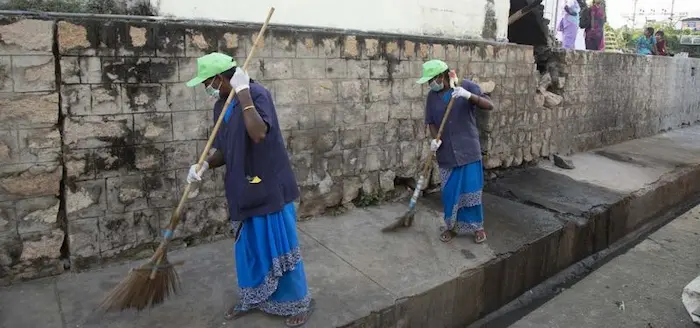
Why in News?
A social audit presented in Parliament reported 150 hazardous cleaning deaths in 2022–23, raising concerns about continued manual scavenging, weak enforcement of laws, and underfunding of key schemes like NAMASTE, despite Supreme Court orders and successful state models.
Key Takeaways
- Manual Scavenging: Banned under the Prohibition of Employment as Manual Scavengers and their Rehabilitation Act, 2013, but continues in practice.
- NAMASTE Scheme:
- Full Form: National Action for Mechanized Sanitation Ecosystem
- Launched to promote mechanized sanitation and rehabilitation of sanitation workers.
- Statistics (2022–23):
- 150 deaths due to hazardous cleaning
- Of 57,758 workers identified, only 16,791 received PPE kits
- Budget allocation: ₹14 crore – deemed inadequate
- Successful State Models:
- Odisha & Tamil Nadu lead in mechanization (use of vacuum trucks, robotics).
- Employer Liability Gaps:
- Only 5 of 54 deceased workers were on government payroll—subcontracting hides accountability.
- Lack of Rural Data:
- Rural sanitation workers often unregistered, receive no protective gear (e.g., Chhattisgarh case).
In-Depth Explanation
Despite a legal ban on manual scavenging, India continues to report deaths from hazardous sewer and septic tank cleaning, revealing systemic governance failures. The persistence of these practices underscores critical gaps in law enforcement, worker safety, funding, and data collection.
Legal and Policy Framework:
- The 2013 Act criminalizes manual scavenging and mandates worker rehabilitation.
- Supreme Court directives (2014): Recognized the act as a violation of human dignity and directed compensation and rehabilitation.
- NAMASTE (2022): Envisions a mechanized sanitation ecosystem, but implementation remains limited due to poor funding and outreach.
Key Issues Identified:
- Poor Law Enforcement: Laws exist, but convictions and monitoring are rare.
- Subcontracting of Labor: Allows both public and private employers to evade responsibility.
- Underfunding: The modest ₹14 crore allocation is insufficient for a nationwide mechanization push.
- Lack of Rural Focus: Most schemes ignore non-urban sanitation workers, who remain undocumented and unprotected.
Best Practices – Odisha and Tamil Nadu:
- Use of vacuum and suction machines, GPS tracking, and robotic arms to eliminate manual entry into sewers.
- Training, insurance, and employment tracking systems in place for sanitation workers.
Recommendations:
- Mandatory mechanization and banning manual entry in all sanitation work.
- Accountability frameworks for contractors and local bodies.
- Comprehensive worker database, including rural areas.
- Budgetary scaling of NAMASTE and linkage with health insurance (e.g., Ayushman Bharat).
This is not just a sanitation issue, but a question of dignity, equity, and state accountability.
Exam Connect – Possible Questions
Prelims
1. The NAMASTE scheme is associated with:
A. Tribal health and nutrition
B. Women’s self-help groups
C. Mechanization of sanitation and worker rehabilitation
D. Skill development for artisans
Answer: C. Mechanization of sanitation and worker rehabilitation
2. The Prohibition of Employment as Manual Scavengers and their Rehabilitation Act was enacted in:
A. 2010
B. 2013
C. 2015
D. 2018
Answer: B. 2013
3. Which of the following states have implemented successful mechanized sanitation models?
1.Odisha
2. Bihar
3. Tamil Nadu
4.Rajasthan
Select the correct option:
A. 1 and 2 only
B. 2 and 3 only
C. 1 and 3 only
D. 3 and 4 only
Answer: C. 1 and 3 only
Mains
1. Despite legal bans, manual scavenging continues in India. Analyze the structural and implementation challenges that hinder the eradication of this practice.
2. Discuss the significance and limitations of schemes like NAMASTE in addressing the issues of sanitation worker safety and mechanization. Suggest reforms to strengthen the ecosystem.
3. Subcontracting in sanitation work has obscured employer accountability and increased worker vulnerability. Evaluate this statement in the context of recent findings.
6. Palna Scheme: Strengthening Early Childcare in India – Governance
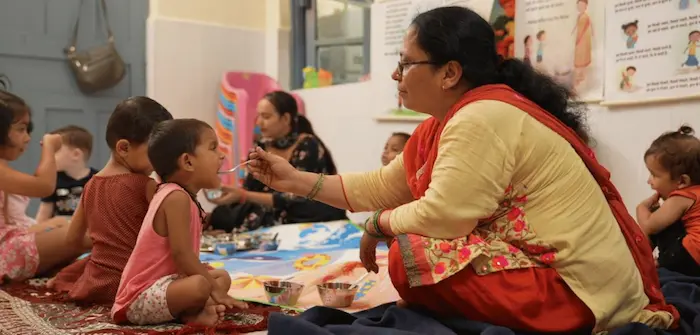
Why in News?
The Minister of State for Women and Child Development recently addressed the Rajya Sabha on the progress and impact of the Palna Scheme, a childcare initiative aimed at supporting children aged 6 months to 6 years across India.
Key Takeaways
- Launched by: Ministry of Women and Child Development
- Type of Scheme: Centrally Sponsored Scheme
- Target Group: Children aged 6 months to 6 years
- Eligibility: Available to all mothers, irrespective of employment status
- Crèche Types:
- Standalone Crèches
- Anganwadi-cum-Crèches (AWCCs)
- Operational Guidelines:
- Open 26 days/month
- Operate for 7.5 hours/day
- Flexible timing based on local needs
- Funding Pattern:
- General States: 60:40 (Centre:State)
- NE & Special Category States: 90:10
- UTs with Legislature: 60:40
- UTs without Legislature: 100% Centre-funded
In-Depth Explanation
The Palna Scheme is a key initiative in India’s social welfare architecture aimed at improving early childhood care. By targeting children under 6 years of age—especially those in vulnerable and low-income families—it addresses critical aspects of nutrition, health, early education, and parental support.
Objectives of the Scheme:
- Create a safe and stimulating environment for infants and toddlers
- Ensure nutritional security and healthcare access
- Promote early learning, especially for children aged 3–6 years
- Provide relief to working and non-working mothers, encouraging broader women’s participation in the workforce
Services Provided:
- Daycare and sleeping facilities
- Supplementary nutrition, sourced from local food supply systems
- Health check-ups, immunizations, and growth monitoring
- Early stimulation for infants and pre-school education for older children
Why the Scheme Matters:
- Addresses a crucial gap in childcare infrastructure at the grassroots level
- Offers a community-based model integrated with Anganwadi services
- Ensures gender-inclusive development by easing caregiving burdens on women
- Supports early childhood development (ECD), which is critical for long-term cognitive and emotional growth
Despite its potential, challenges remain in terms of coverage, awareness, funding adequacy, and quality of services in remote areas.
Exam Connect – Possible Questions
Prelims
1. The Palna Scheme is implemented by which ministry?
A. Ministry of Health and Family Welfare
B. Ministry of Education
C. Ministry of Women and Child Development
D. Ministry of Social Justice and Empowerment
Answer: C. Ministry of Women and Child Development
2. Which of the following services are covered under the Palna Scheme?
1. Early childhood education
2. Supplementary nutrition
3.Maternity benefits
4.Health check-ups and immunization
Select the correct option:
A. 1, 2 and 3 only
B. 1, 2 and 4 only
C. 2 and 3 only
D. 1 and 4 only
Answer: B. 1, 2 and 4 only
3. What is the funding ratio between Centre and State under the Palna Scheme for North-Eastern and Special Category States?
A. 100:0
B. 60:40
C. 90:10
D. 75:25
Answer: C. 90:10
Mains
1. Discuss the role of the Palna Scheme in promoting early childhood care and education in India. How does it contribute to inclusive governance and gender equity?
2. Evaluate the key challenges in implementing the Palna Scheme, particularly in rural and underdeveloped regions. Suggest policy reforms to enhance its impact.
3. How can schemes like Palna be better integrated with existing platforms like Anganwadi services and POSHAN Abhiyan to create a holistic childcare ecosystem?
7. Coral Loss in Lakshadweep: A Wake-up Call for Marine Ecosystem Protection – Environment
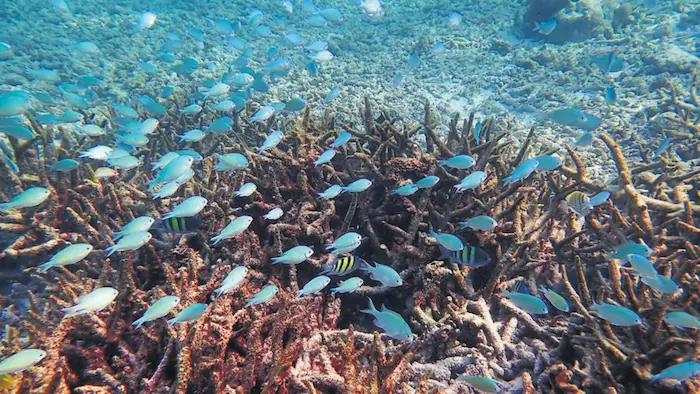
Why in News?
A 24-year study (1998–2022) by the Nature Conservation Foundation has revealed a 50% decline in live coral cover in the Lakshadweep Islands, attributing the loss primarily to repeated marine heatwaves linked to climate change.
Key Takeaways
- Study Duration: 1998–2022
- Coral Cover Decline: From 37.2% to 19.6%
- Study Sites: Agatti, Kadmat, and Kavaratti atolls
- Main Cause: Marine heatwaves driven by climate change
- Recovery Requirement: At least 6 consecutive years without bleaching for healthy coral regeneration
Understanding Coral Ecosystems (Conceptual Clarity)
What are Corals?
- Marine animals made of tiny polyps that form calcium carbonate skeletons
- Host zooxanthellae (algae), which perform photosynthesis and supply nutrients
Types of Corals:
- Hard Corals: Reef-building (e.g., brain coral, staghorn coral)
- Soft Corals: Do not form reefs, flexible structures on existing reefs
Coral Habitat Requirements:
- Temperature: Prefer 20–21°C
- Depth: Usually found at <90 metres
- Salinity: 27–30 ppt
- Water Quality: Clean, clear, low in sediment
- Currents: Nutrient-rich ocean flow is critical
What is Coral Bleaching?
- Triggered by heat stress, pollution, or acidification
- Algae (zooxanthellae) are expelled, leading to whitening of corals
- Without algae, corals lose their food source and may die if the stress continues
In-Depth Explanation (Mains-Focused)
The 50% decline in coral cover in Lakshadweep is not just an ecological warning—it is a climate emergency indicator. Coral reefs serve as the foundation of marine ecosystems, supporting biodiversity, fisheries, and coastal protection.
Key Observations from the Study:
- Six coral response clusters were identified based on:
- Depth
- Wave exposure
- Thermal resistance
- Recovery potential
- Even thermally resistant coral species are reaching tipping points under repeated stress
Implications for India:
- Fisheries-dependent livelihoods in Lakshadweep are at risk
- Coral degradation leads to coastal erosion and reduced tourism potential
- Undermines India’s commitment to marine conservation and SDG-14 (Life Below Water)
Policy & Conservation Measures Needed:
- Strengthen Marine Protected Areas (MPAs) in Lakshadweep
- Promote community-led reef restoration programs
- Integrate coral conservation into India’s climate adaptation strategy
- Invest in early warning systems for marine heatwaves
- Curtail coastal pollution, unsustainable fishing, and unregulated tourism
Exam Connect – Possible Questions
Prelims
1. Coral bleaching occurs primarily due to:
A. Increase in water salinity
B. Decrease in oceanic nutrient content
C. Prolonged exposure to high temperatures
D. Reduction in sea level
Answer: C. Prolonged exposure to high temperatures
2. Which of the following conditions are essential for healthy coral reef growth?
1.Warm and shallow waters
2.High sedimentation levels
3.Optimal salinity (27–30 ppt)
4.Depths beyond 200 metres
Select the correct option:
A. 1 and 2 only
B. 1 and 3 only
C. 2 and 4 only
D. 1, 3 and 4 only
Answer: B. 1 and 3 only
3. The Lakshadweep coral ecosystem is facing stress primarily due to:
A. Overfishing by foreign vessels
B. Invasive species
C. Repeated marine heatwaves
D. Increased mangrove growth
Answer: C. Repeated marine heatwaves
Mains
1. Coral reefs are considered the “rainforests of the sea.” Discuss the ecological and economic significance of coral reefs, with special reference to Lakshadweep. What are the threats they face and how can they be protected?
2. Examine the impact of climate-induced marine heatwaves on India’s coral ecosystems. Suggest policy measures for coral reef conservation in island territories.
3. The loss of coral cover in India’s island territories is an urgent call for integrated coastal and marine management. Critically analyze.

